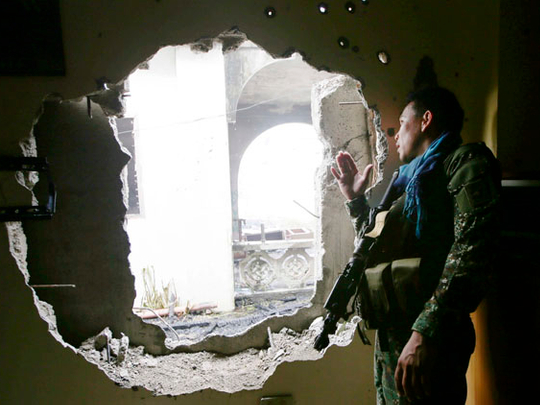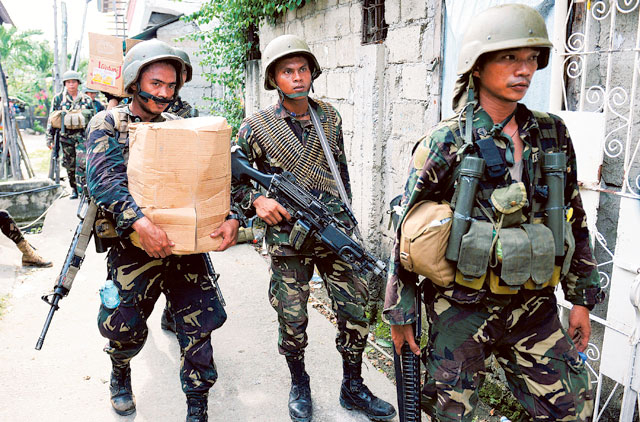
Manila: Philippine government soldiers entered damaged coastal villages that were abandoned by commanders of a Filipino-Muslim rebel group who renewed their armed struggle last Monday.
The rebel group attacked more than five residential villages, held hundreds of hostages, and left more than 60 dead, 70 wounded and 70,000 displaced in the southern Philippines, officials said.
Some of the six coastal villages that were once dominated by Haber Malik, one of the commanders of the Moro National Liberation Front (MNLF), have been “curtailed and contained by government soldiers,” said Interior and Local Government Secretary Mar Roxas on TV.
Some 3,000 elite troops were ordered to breach the once MNLF-controlled villages and control the rest that were not yet cleared of MNLF rebels, said Roxas, hinting of a government’s victory.
In Sta. Barbara village, government soldiers found a pockmarked altar of a Catholic Church. Soldiers recovered unused warheads of rocket propelled grenades, including bodies of slain MNLF rebels, radio and reports said.
“There was smog everywhere because of the 200 homes and buildings that were set on fire,” said one soldier who sent a text message to Gulf News. More homes and structures were burned in other MNLF-occupied villages that were already re-taken by government forces.
“A lot of rehabilitation projects will be needed here,” said the same soldier who requested not to be named.
There were reports that the ceasefire that was planned by Vice President Jejomar Binay after he talked over the phone last Friday with MNLF founding chairman Nur Misuari and Defence Chief Voltaire Gazmin had failed.
But the absence of top MNLF rebels at the villages that they had occupied earlier, and the increasing number of displaced residents from the occupied villages were “tell-tale signs that an agreement to ease the tension was also reached,” said an observer from Zamboanga who also refused to be identified.
It had been earlier planned that hostages would be brought to a place where emissaries would allow government representatives to bring them to a safe place, said the source.
They added that this was the reason why vehicles provided by the local government managed to bring out trapped residents from the MNLF-occupied villages.
There was also a plan to give Haber Malik’s group, including other MNLF commanders and their followers, a safe conduct pass, said the source.
This process was to be overseen by an international observer, earlier identified as representatives of the Indonesian government, a member country of the Organisation of Islamic Cooperation (OIC), which brokered the Philippine government and MNLF peace settlement that was signed in 1996, after four years of peace talks, said the same source.
Some 19 MNLF rebels were arrested, said Lt Col Ramon Zagala, spokesperson of the military. Earlier reports said that a total of 180 MNLF rebels waged an armed struggle by taking over six villages in Zamboanga starting last Monday.
Of the 62 fatalities, 51 were MNLF rebels, six were soldiers, a policeman and four civilians. With 19 of the MNLF rebels arrested, about 110 could not be accounted for.
When there were reports that President Aquino did not sanction the implementation of the ceasefire agreement, it was presumed that details of the agreement were not implemented at all, said the source.
There were also reports that the Philippine government agreed to appease Misuari by holding a review, together with the OIC and the MNLF, the implementation of the 1996 Philippine government and MNLF peace accord.
Earlier, a senior official in charge of peace talks said that even before the MNLF rebels attacked the residential villages in Zamboanga, a tripartite review was long scheduled in Indonesia on September 16.
Mayor Maria Isabelle Salazar of Zambaonga also said that City Council passed a resolution on Friday that allowed the national government to take over and manage the conflict resolution in Zamboanga. This was the reason why President Aquino flew to Zamboanga City on Friday, and Vice President Binay went there on Saturday.
The military is still on a “calibrated military response” mode, said Salazar, adding that soldiers are now focused on pushing out MNLF rebels from two villages in Zamboanga. They have less than 20 hostages, he added.
Meanwhile, the problem now lies in the commercial area of Zamboanga City which remained paralysed and ghost-like.
Noting the extent of the job to be undertaken by the department of social welfare, Welfare Secretary Corazon Soliman said that the evacuees could go home after several weeks, when their places are already secured from rebel attacks. Livelihood projects for them must be established, she added.
Some 44,000 people or 7,000 families were placed at the Joaquin Enriquez Sports Complex. The rest were placed at 20 evacuation centres.
The MNLF had forged a pro-autonomy peace settlement with the Philippine government in Libya in 1976, and in the Philippines in 1996.
In 1978, because of the Philippine government-MNLF pro-autonomy peace accord, the Moro Islamic Liberation Front (MILF) became a faction of the MNLF. At the time, the MILF pursued a secessionist stance. Both of them waged a separatist war that killed 150,000 in the early 70s.
After he forged a new pro-autonomy peace settlement with the Philippine government in 1996, Misuari was elected governor of the Autonomous Region in Muslim Mindanao (ARMM) in 1996. Congress amended a law and allowed a second referendum for autonomy, which increased ARMM’s area. It is now composed of five provinces and one city.
In 1997, the MILF gave up its secessionist stance when it responded to the pro-autonomy peace initiative of the Philippine government.
In 2012, the Philippine government and the MILF forged a framework agreement, which allowed in principle the expansion of the ARMM with six towns and 800-Muslim dominated villages in the south, which had voted for autonomy in the 2001 referendum. Both camps also called for enhanced self-governance. They are to finalise details of the agreement, for Congressional approval in 2015, and implementation in 2016, the end of Aquino’s term.
Misuari said he was sidelined in these talks. And he resented the Philippine government’s refusal to continue reviewing the implementation of the Philippine government-MNLF peace accord in 1996.












